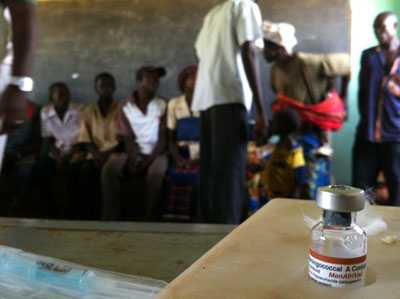Meningococcal Disease in Other Countries
Meningococcal disease is found worldwide, with the highest incidence of disease found in the ‘meningitis belt’ of sub-Saharan Africa. In this region, major epidemics occur every 5 to 12 years with attack rates reaching 1,000 cases per 100,000 population. Other regions of the world experience lower overall rates of disease and occasional outbreaks, with annual attack rates of around 0.3 to 3 per 100,000 population.
In the meningitis belt, serogroup A has historically accounted for 90% of meningococcal disease cases and the majority of large-scale epidemics. Starting in 2010, a monovalent serogroup A meningococcal conjugate vaccine (MenAfriVac™) has been progressively rolled out through mass vaccination campaigns of 1 through 29 year olds. This occurred in 16 of the 26 target countries as of December 2015, with introduction of the vaccine into the routine immunization program for children ongoing. Following vaccine introduction, epidemics due to serogroup A have been eliminated [1.3 MB, 8 pages] in vaccination areas, and recent epidemics have been primarily due to serogroups C and W. Serogroup X outbreaks have also been previously reported in this region. While all the risk factors for meningococcal disease outbreaks in Africa are not understood, dry and dusty conditions during the dry season between December to June, along with immunological susceptibility of the population, travel and large population displacements, and crowded living conditions create favorable conditions for meningococcal disease epidemics.
In Europe, the Americas, and Australia, serogroups B, C, and Y together account for a large majority of cases, though increasing numbers of serogroup W have been observed in some areas. In temperate regions the number of cases increases in winter and spring. The annual Hajj pilgrimage has also been associated with outbreaks of meningococcal disease due to serogroups A and W.
CDC Response to Meningococcal Disease in Africa
In collaboration with the World Health Organization, Agence Médecine Préventive, African ministries of health, and other partners, CDC leads an international consortium called MenAfriNet to strengthen meningitis surveillance in sub-Saharan Africa in order to evaluate the impact of MenAfriVac™ on the incidence of meningococcal disease due to serogroup A as well as to monitor the emergence of disease and epidemics due to other serogroups. Learn more about MenAfriNet.

Photo of the MenAfriVac™ vaccine in Burkina Faso.
Video: CDC Responds to Meningitis in Burkina Faso
Epidemics of meningococcal meningitis in Africa can affect hundreds of thousands of people and kill many thousands. Learn how CDC has contributed to development of an inexpensive vaccine and is now working with partners to ensure it is used where needed most and evaluated for effectiveness…more
Resources
- CDC’s Integrated Disease Surveillance and Response (IDSR)
IDSR strategy aims to improve the availability and use of surveillance and laboratory data. - CDC Traveler’s Health: Meningococcal Disease
Meningococcal recommendations for travelers. - MenAfriNet
A network of international partners supporting quality meningitis data for Africa to evaluate the impact of MenAfriVac™. - Meningococcal Vaccine Project (MVP)
A partnership between the World Health Organization (WHO) and the Program for Appropriate Technology in Health (PATH) with a goal to eliminate epidemic meningococcal as a public health problem in Sub-Saharan Africa. - Pediatric Bacterial Meningitis Surveillance Network—African Region, 2002 – 2008
- Sentinel Surveillance for Pediatric Bacterial Meningitis in the World Health Organization African Region, 2001 – 2009 [4 pages]
- Meningococcal Outbreaks
Link to WHO list archive of meningococcal outbreaks
- Page last reviewed: October 13, 2016
- Page last updated: July 3, 2017
- Content source:
- Content source: National Center for Immunization and Respiratory Diseases



 ShareCompartir
ShareCompartir